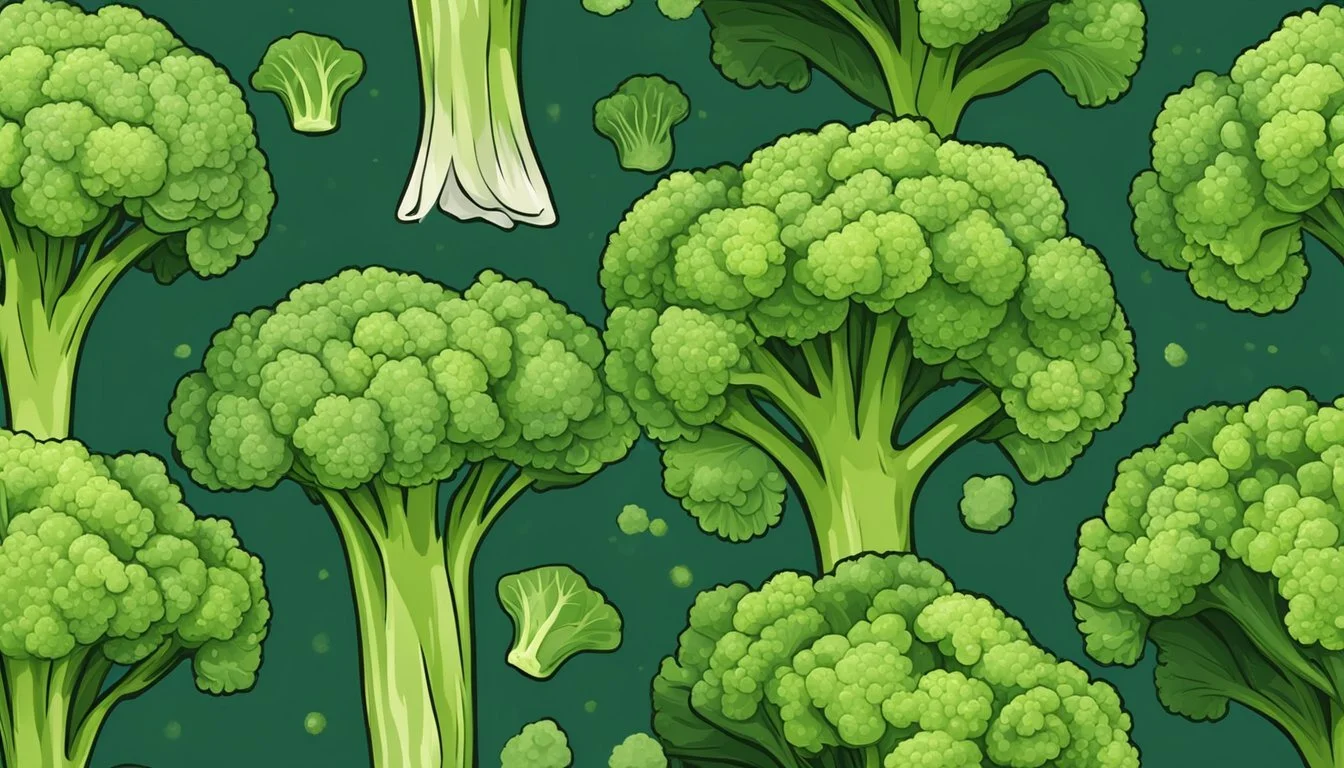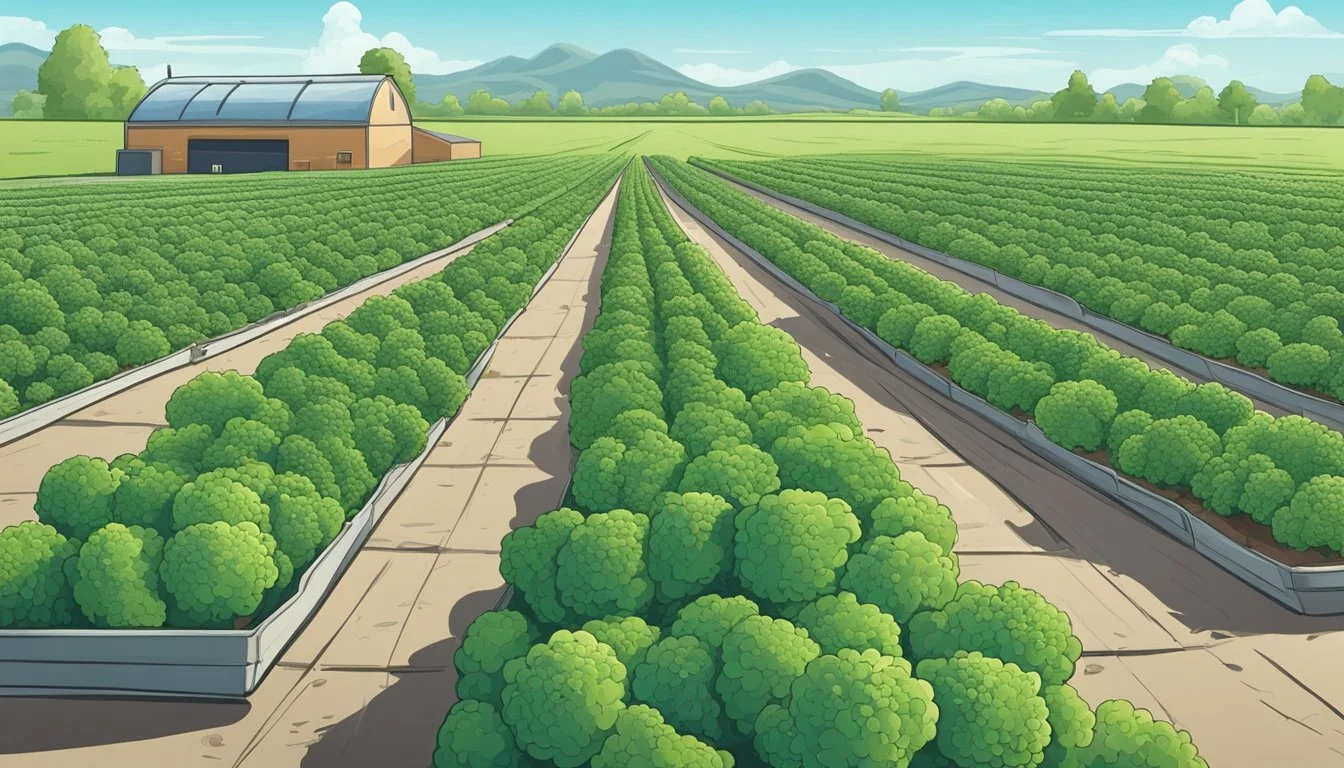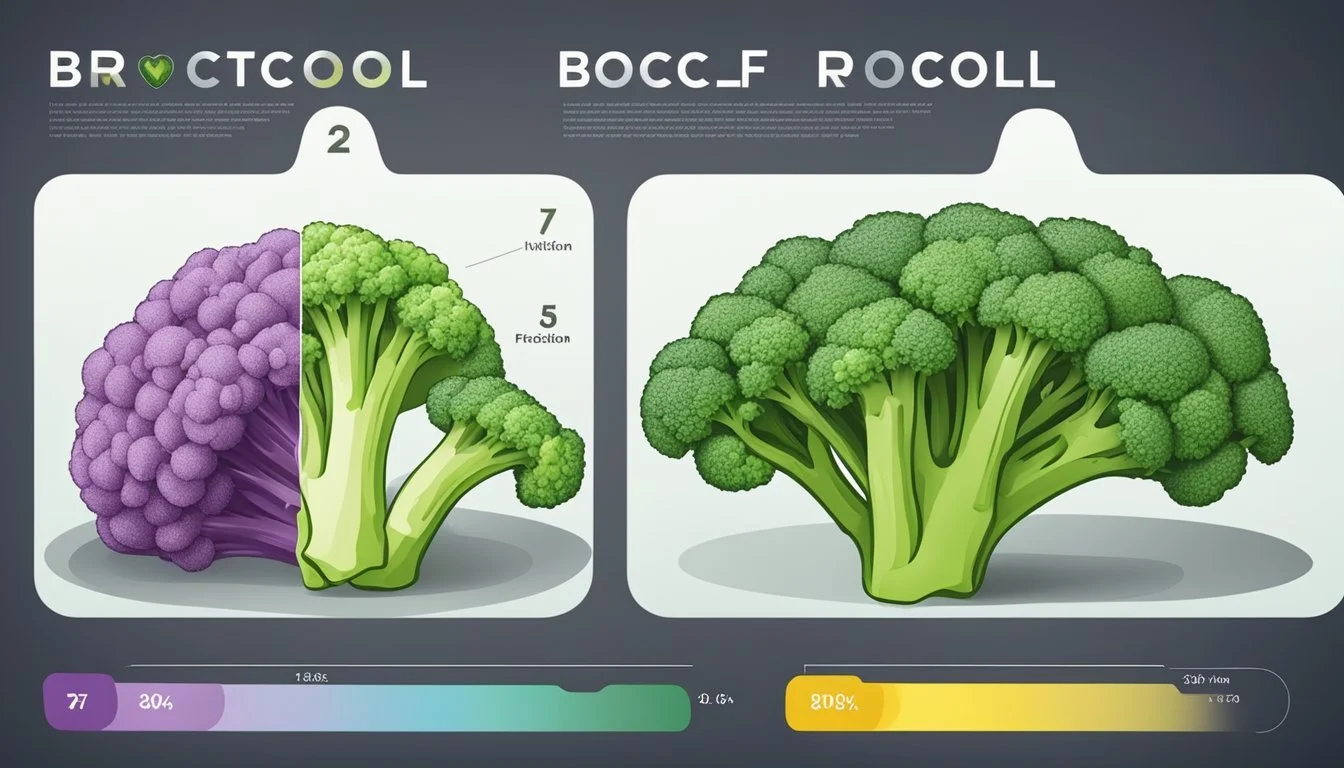Fresh vs. Frozen Broccoli: A Nutritional Showdown
Broccoli stands out as a nutritional powerhouse, offering a wealth of vitamins, minerals, and antioxidants. When choosing between fresh and frozen broccoli, consumers often wonder which option provides the most nutritional benefits.
Both fresh and frozen broccoli can be excellent sources of nutrients, with frozen broccoli sometimes retaining more vitamin C than its fresh counterpart. Studies have shown that freezing can preserve nutrients effectively, especially when the broccoli is frozen shortly after harvest.
Fresh broccoli offers a satisfying crunch and vibrant flavor, but its nutrient content can decline over time, especially if not stored properly. Frozen broccoli, on the other hand, maintains its nutritional value for longer periods. This makes frozen broccoli a convenient and nutritious option for those who may not have frequent access to fresh produce or prefer to stock up on vegetables for later use.
Understanding Broccoli Nutrition
Broccoli is a nutritional powerhouse packed with essential vitamins, minerals, and beneficial compounds. Its nutrient profile supports various aspects of health and well-being.
Nutrient Profile of Broccoli
Broccoli is low in calories but rich in nutrients. A 100-gram serving contains:
Vitamin C: 89.2 mg (149% of Daily Value)
Vitamin K: 101.6 μg (127% of DV)
Folate: 63 μg (16% of DV)
Potassium: 316 mg (9% of DV)
Fiber: 2.6 g (10% of DV)
It also provides vitamin A, calcium, and iron. Broccoli contains powerful antioxidants like sulforaphane and indole-3-carbinol. These compounds help protect cells from damage.
The vegetable is low in fat and carbohydrates while offering a modest amount of plant-based protein. Its high water content contributes to hydration.
Health Benefits of Broccoli
Broccoli's nutrient profile translates to numerous health benefits. Its high vitamin C content boosts immune function and supports skin health. Vitamin K aids in blood clotting and bone health.
The fiber in broccoli promotes digestive health and helps maintain healthy blood sugar levels. Antioxidants like beta-carotene and vitamin E combat oxidative stress in the body.
Broccoli's sulforaphane has been linked to potential cancer-fighting properties. The vegetable's folate content supports cell division and DNA synthesis, crucial for pregnant women.
Regular consumption of broccoli may help reduce inflammation, support heart health, and aid in maintaining healthy cholesterol levels. Its low calorie content makes it an excellent choice for weight management.
Fresh vs Frozen Broccoli
Fresh and frozen broccoli offer distinct characteristics in terms of texture, flavor, and nutritional content. The freezing process impacts broccoli's properties, leading to differences between the two forms.
Texture and Flavor Comparison
Fresh broccoli boasts a crisp texture and vibrant green color. Its florets have a firm bite, while the stems remain crunchy. The fresh variety offers a mild, slightly sweet flavor with subtle earthy notes.
Frozen broccoli undergoes blanching before freezing, which softens its texture. Upon thawing and cooking, it becomes more tender compared to its fresh counterpart. The freezing process can slightly alter the flavor, making it milder.
Color differences are noticeable, with frozen broccoli appearing darker green due to the blanching process. This color change doesn't significantly impact nutritional value.
Nutritional Differences
Both fresh and frozen broccoli are nutritious options, but some differences exist:
Vitamin C: Fresh broccoli initially contains higher levels of vitamin C. However, it begins to degrade after harvesting.
Frozen broccoli retains more vitamin C due to the flash-freezing process, which halts nutrient degradation.
Nutrient Fresh Broccoli Frozen Broccoli Vitamin C Higher initially, degrades over time More stable due to freezing Fiber Similar levels Similar levels Antioxidants Slightly higher Preserved well
Frozen broccoli may have slightly lower water-soluble vitamin content due to blanching. However, it often retains more nutrients overall compared to fresh broccoli that has been stored for extended periods.
Impact of Freezing on Broccoli
The freezing process significantly affects broccoli's properties:
Nutrient preservation: Flash-freezing locks in nutrients, maintaining levels of vitamins and minerals.
Enzyme deactivation: Blanching before freezing deactivates enzymes that cause spoilage, extending shelf life.
Texture changes: Ice crystals form during freezing, altering the vegetable's cellular structure and resulting in a softer texture upon thawing.
Frozen broccoli offers convenience and year-round availability. It reduces food waste as it can be stored for longer periods without spoilage. The blanching process can lead to some nutrient loss, particularly water-soluble vitamins.
However, the overall nutritional value of frozen broccoli remains high, often surpassing that of fresh broccoli that has been stored for extended periods or transported long distances.
How Freezing Affects Produce
Freezing produce impacts its nutritional content and quality in several ways. The process involves specific steps that can alter vitamin and mineral levels while also helping preserve certain nutrients.
Blanching Process and Nutritional Implications
Blanching is a crucial step before freezing most vegetables. It involves briefly immersing produce in boiling water or steam. This process inactivates enzymes that can cause flavor, color, and texture changes during freezing.
Blanching can lead to some nutrient losses, particularly water-soluble vitamins like vitamin C and B vitamins. However, it also makes certain nutrients more bioavailable. For example, blanching increases the absorption of beta-carotene in carrots and lycopene in tomatoes.
The duration of blanching affects nutrient retention. Longer blanching times result in greater nutrient losses. Proper blanching technique minimizes these losses while ensuring food safety and quality.
Preservation of Nutrients in Frozen Produce
Freezing effectively locks in nutrients present at the time of processing. This can result in frozen produce having higher nutrient levels than fresh produce that has been stored for several days.
Frozen fruits and vegetables retain most of their vitamins and minerals. Vitamin C is well-preserved in frozen produce, often at higher levels than in fresh produce stored at room temperature. Minerals like calcium, iron, and magnesium are largely unaffected by freezing.
Some antioxidants, like anthocyanins in blueberries, remain stable during freezing. Others may decrease slightly but still maintain significant levels. Fiber content is not affected by freezing.
Proper freezing and storage temperatures are essential for maintaining nutrient levels. Fluctuating temperatures can lead to nutrient degradation and quality loss in frozen produce.
Comparative Shelf Life and Convenience
Fresh and frozen broccoli offer different advantages in terms of storage duration and ease of use. Their handling, preservation methods, and cooking applications impact how they fit into a healthy diet.
Fresh vs Frozen Produce Handling
Fresh broccoli requires careful handling to maintain its quality. It should be stored unwashed in the refrigerator's crisper drawer. Proper air circulation helps prevent moisture buildup and spoilage. Frozen broccoli is pre-washed and cut, eliminating these preparation steps.
Fresh broccoli needs inspection for any signs of yellowing or softening. Frozen broccoli maintains its quality without this regular checking. This difference in handling can affect the overall convenience for consumers, especially those with busy lifestyles.
Storage and Lifespan
Fresh broccoli typically lasts 3-5 days in the refrigerator when stored properly. Its short shelf life means more frequent shopping trips may be necessary. Frozen broccoli can be kept in the freezer for up to 12 months without significant quality loss.
The extended storage time of frozen broccoli reduces food waste. It allows for bulk purchases and long-term meal planning. Fresh broccoli's limited lifespan may lead to spoilage if not used quickly.
Table: Storage Duration Comparison
Type Refrigerator Freezer Fresh 3-5 days N/A Frozen N/A 1 year
Convenience in Everyday Cooking
Frozen broccoli offers ready-to-use portions, saving time on washing and cutting. It's ideal for quick meals, soups, casseroles, and smoothies. Fresh broccoli requires more preparation but provides a crisp texture suitable for salads and stir-fries.
Frozen broccoli eliminates the need for immediate use, providing flexibility in meal planning. It's pre-blanched, reducing cooking time. Fresh broccoli allows for varied cooking methods and retains its firm texture when lightly cooked.
Both types can contribute to a healthy diet. The choice often depends on specific recipe requirements and personal cooking habits.
Economic Considerations
The choice between fresh and frozen broccoli involves important financial factors. Price differences and storage considerations can significantly impact household budgets and grocery shopping habits.
Cost Comparison of Fresh and Frozen Broccoli
Frozen broccoli often proves more cost-effective than its fresh counterpart. Supermarkets typically price frozen broccoli lower due to reduced transportation and storage costs. Fresh broccoli requires careful handling and refrigeration, increasing its retail price.
Buying fresh broccoli in season can lead to savings, but prices fluctuate throughout the year. Frozen broccoli maintains a more stable price point, allowing for easier budget planning.
Storage duration also affects cost-effectiveness. Fresh broccoli has a limited shelf life, potentially leading to waste if not consumed quickly. Frozen broccoli lasts much longer, reducing the risk of spoilage and food waste.
Bulk purchasing options for frozen broccoli can further reduce costs. Many stores offer discounts on larger bags or multi-pack deals, allowing consumers to stock up and save.
Health Implications of Broccoli Forms
Broccoli offers significant health benefits in both fresh and frozen forms. The way it's prepared and consumed can impact its nutritional profile and disease-fighting properties.
Risks and Benefits of Fresh vs Frozen Varieties
Fresh broccoli provides optimal taste and texture. It retains its full complement of vitamins and minerals when consumed soon after harvest. However, fresh broccoli can lose nutrients during transportation and storage.
Frozen broccoli offers convenience and a longer shelf life. The flash-freezing process preserves nutrients, sometimes even increasing certain vitamins like riboflavin (vitamin B2). This antioxidant boosts energy levels and supports immune function.
Both forms contain fiber, vitamins C and K, and beneficial plant compounds. The choice between fresh and frozen often comes down to personal preference and practical considerations.
Role in Reducing Disease
Broccoli, regardless of form, plays a crucial role in disease prevention. Its high antioxidant content helps protect cells from damage.
Cruciferous vegetables like broccoli may:
Prevent DNA damage
Inhibit cancer cell spread
Boost liver detoxification enzymes
Reduce prostate cancer progression risk
Regular broccoli consumption is linked to lower risks of cardiovascular disease and certain cancers. The vegetable's fiber content supports digestive health and may help manage blood sugar levels.
Broccoli's sulforaphane, a potent compound, activates cellular defenses against pathogens and pollutants. This contributes to overall health and disease resistance.
Impact of Processing on Broccoli
Processing methods affect broccoli's nutritional content and quality. Freezing and additives can influence nutrient retention, while regulatory standards ensure safety.
Additives and Preservatives in Frozen Broccoli
Frozen broccoli often contains additives to maintain quality during storage. Antioxidants like ascorbic acid help prevent browning and nutrient loss. Salt may be added to enhance flavor and act as a preservative.
Some producers use natural plant extracts as preservatives. These additives extend shelf life by inhibiting bacterial growth. Citric acid is commonly used to maintain color and freshness.
Frozen broccoli is typically blanched before freezing. This process inactivates enzymes that could cause quality deterioration. Blanching can lead to some nutrient loss, particularly water-soluble vitamins like vitamin C.
Compliance with USDA and FDA Standards
The USDA and FDA set strict guidelines for frozen vegetable processing. These standards ensure food safety and quality. Processors must follow Good Manufacturing Practices (GMPs) to prevent contamination.
Regular inspections verify compliance with sanitation and safety protocols. The USDA grades frozen broccoli based on quality factors like color, defects, and tenderness.
FDA regulations limit the types and amounts of additives allowed in frozen vegetables. Labels must accurately list all ingredients. Frozen broccoli must be stored at 0°F (-18°C) or below to maintain safety and quality.
Processors use airtight packaging to prevent freezer burn and bacterial growth. This packaging helps maintain nutritional quality during long-term frozen storage.
Consumer Choices and Personal Preferences
When selecting broccoli, shoppers weigh various factors to determine whether fresh or frozen best suits their needs. Individual preferences, lifestyle considerations, and nutritional priorities all play a role in this decision-making process.
Influence on Buying Behavior
Many consumers prioritize freshness, associating it with higher quality and better taste. This perception often leads to a preference for fresh broccoli, especially when planning to use it immediately. Frozen broccoli, however, appeals to those seeking convenience and longer shelf life. Its availability year-round and quick preparation make it attractive for busy households.
Price fluctuations also affect buying decisions. Fresh broccoli prices may vary seasonally, while frozen options typically maintain more stable pricing. Budget-conscious shoppers might opt for frozen when fresh prices spike.
Factors Contributing to Individual Selection
Nutritional awareness influences choices significantly. Some buyers select fresh broccoli, believing it retains more nutrients. Others choose frozen, knowing it's flash-frozen at peak ripeness, preserving vitamin content effectively.
Cooking methods impact selection too. Fresh broccoli is favored for raw consumption or light steaming. Frozen varieties excel in cooked dishes, maintaining texture and flavor well.
Storage capacity affects decisions. Those with limited freezer space may prefer fresh, while others appreciate the long-term storage of frozen options.
Taste preferences vary. Some find fresh broccoli's crisp texture superior, while others enjoy the consistency of frozen in certain recipes.
Environmental concerns can sway choices. Local, fresh broccoli may appeal to those aiming to reduce food miles. Frozen options can reduce food waste, as unused portions remain preserved for future use.
Environmental and Sustainability Aspect
The choice between fresh and frozen broccoli has significant implications for environmental sustainability and food waste. Both options present unique challenges and benefits in terms of resource use, transportation, and shelf life.
Food Waste Concerns with Fresh Produce
Fresh broccoli's limited shelf life contributes to food waste issues. Farmers must harvest at peak ripeness, leaving a narrow window for transportation and consumption. Unsold or spoiled broccoli in stores and homes often ends up discarded. This waste extends beyond the produce itself, encompassing the water, energy, and resources used in cultivation.
Retailers frequently over-order fresh broccoli to maintain appealing displays, further exacerbating waste. Home consumers may struggle to use fresh broccoli before it spoils, especially when purchased in bulk. Proper storage can extend shelf life, but many consumers lack awareness of optimal storage methods.
Sourcing and Impact of Frozen Broccoli Production
Frozen broccoli offers advantages in reducing food waste. The freezing process allows for harvesting at peak ripeness and preserving nutritional value. This extends the usable life of broccoli, reducing spoilage during distribution and storage.
The production of frozen broccoli requires energy for processing and freezing. However, this is often offset by reduced transportation needs, as frozen broccoli can be shipped less frequently. Packaging for frozen broccoli typically uses more materials than fresh, creating a trade-off between food waste reduction and packaging waste.
Frozen broccoli production allows for more efficient use of crops. Imperfect or surplus broccoli that might not meet fresh market standards can be processed and frozen, reducing field waste. This practice supports sustainability by maximizing crop utilization.
Recommendations and Bottom Line
Fresh and frozen broccoli both offer excellent nutritional value. The choice between them depends on individual preferences and circumstances.
Frozen broccoli provides convenience and year-round availability. It retains most of its nutrients due to flash-freezing shortly after harvest.
Fresh broccoli may have a slight edge in texture and taste for some people. It's ideal when in season and locally sourced.
For a healthy diet, include broccoli regularly regardless of form. Both fresh and frozen varieties provide essential vitamins, minerals, and fiber.
Consider these factors when choosing:
Availability and seasonality
Storage capacity
Cooking methods
Budget
Mixing fresh and frozen broccoli in your diet can offer the best of both worlds. This approach ensures consistent nutrient intake while enjoying variety in meals.
Remember to prepare broccoli using methods that preserve nutrients, such as steaming or quick stir-frying. Avoid overcooking to maintain nutritional value and texture.
Ultimately, the most nutritious broccoli is the one you'll consistently eat and enjoy as part of a balanced diet.







